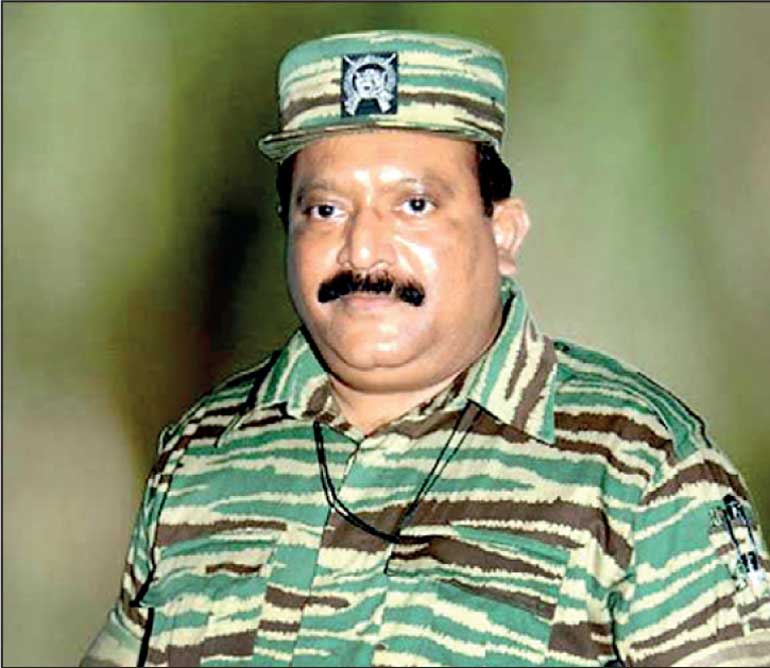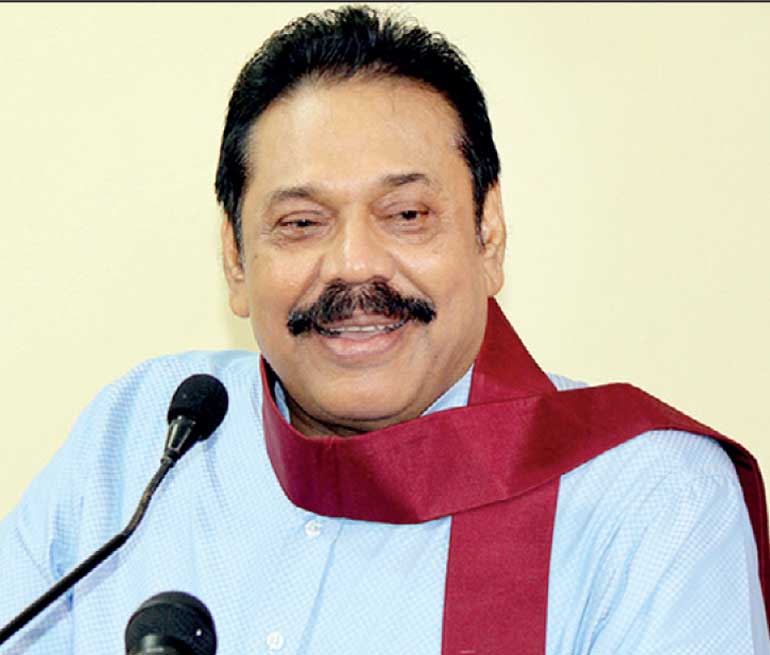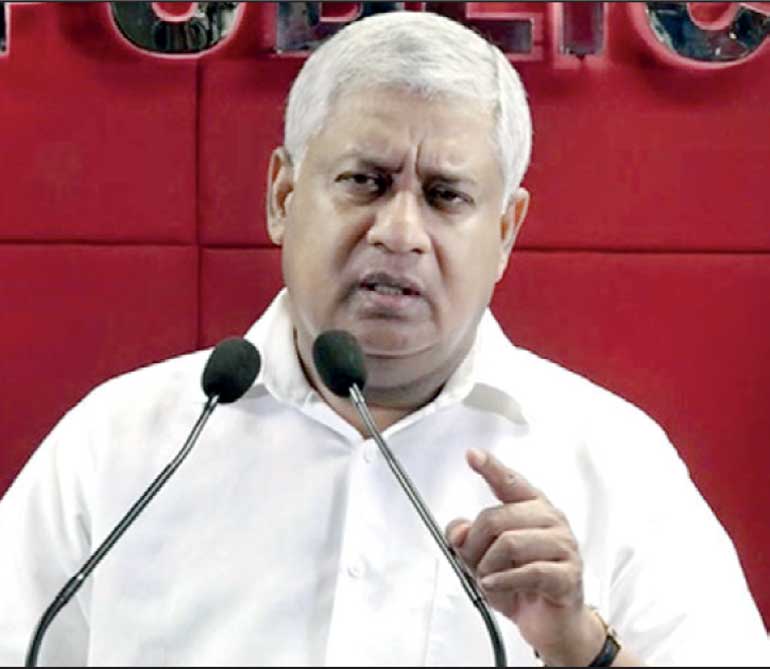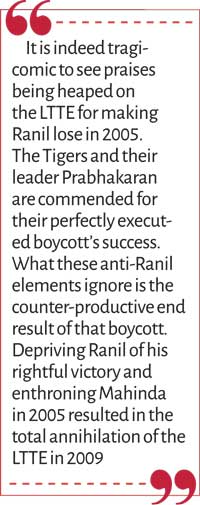Monday Jan 12, 2026
Monday Jan 12, 2026
Wednesday, 30 August 2023 00:55 - - {{hitsCtrl.values.hits}}

LTTE Leader Velupillai Prabhakaran

President Ranil Wickremesinghe

Mahinda Rajapaksa

Tiran Alles
 The first part of this article was published last week under the heading “How and why the LTTE helped Mahinda defeat Ranil in Nov. 2005”. In this second and final part, the focus would be on how the Liberation Tigers of Tamil Eelam (LTTE) enforced a boycott of the November 2005 Presidential elections through violence and intimidation to bring about the defeat of Ranil Wickremesinghe at the presidential elections.
The first part of this article was published last week under the heading “How and why the LTTE helped Mahinda defeat Ranil in Nov. 2005”. In this second and final part, the focus would be on how the Liberation Tigers of Tamil Eelam (LTTE) enforced a boycott of the November 2005 Presidential elections through violence and intimidation to bring about the defeat of Ranil Wickremesinghe at the presidential elections.
The enforced boycott in the Tamil areas of the North and East deprived Wickremesinghe of a large number of potential Tamil votes. This helped his rival Mahinda Rajapaksa win as the LTTE calculated. Ultimately the LTTE’s boycott boomeranged because the advent of Mahinda resulted in an escalation of the war and eventual military defeat for the LTTE.
Re-visiting the LTTE enforced boycott of the 2005 Presidential poll and the consequential electoral defeat of the LTTE known popularly as the Tigers is currently of significant relevance.
As stated last week in this article’s first part, there is a lot of Ranil bashing going on within Sri Lankan Tamil circles now. Many Tamil politicians as well as sections of the Tamil media are being highly critical of President Ranil Wickremesinghe these days.
A key event highlighted or referred to in this anti-Ranil campaign is the 2005 presidential election. It is being emphasised that the LTTE had identified Ranil as an enemy and engineered his defeat at the 2005 poll. The Tigers are being praised for this. It is being overtly and covertly suggested that Wickremesinghe should be defeated in the forthcoming presidential election too. One proposal being mooted is to deprive Ranil of potential Tamil votes by fielding a common Tamil presidential candidate at the next election.
It is indeed tragicomic to see praises being heaped on the LTTE for making Ranil lose in 2005. The Tigers and their leader Prabhakaran are commended for their perfectly executed boycott’s success. What these anti-Ranil elements ignore is the counter-productive end result of that boycott. Depriving Ranil of his rightful victory and enthroning Mahinda in 2005 resulted in the total annihilation of the LTTE in 2009.
And now back to the 2005 boycott. After the LTTE and the TNA announced a boycott in the name of the Tamil people, Ranil Wickremesinghe sent Up Country People’s Front (UCPF) leader Periyasamy Chandrasekaran to meet the LTTE in the Wanni. The LTTE hierarchy in Kilinochchi gave an assurance that the Tigers would not strictly enforce a boycott. They would merely call for a boycott but not adopt any further action to actually implement a boycott. They would leave the matter entirely to the people. They would not stand in the way of voters wishing to exercise their franchise.
LTTE doublespeak
This was unadulterated LTTE doublespeak but the UNP chose to believe it then. The UNP leadership opted to take the Tigers at their “word”. Wickremesinghe did not want concrete guarantees from the LTTE that the boycott would be called off. All that Wickremesinghe wanted then was for the LTTE to refrain from forcibly implementing a boycott. Ranil was confident that if a free choice was left in the hands of the Tamil people, they would vote for him. The UNP was sure that the Tamil people would vote in large numbers for Wickremesinghe if the Tigers did not impose a boycott.
 As election day drew near Wickremesinghe and the UNP exuded confidence of a sure victory because they thought the LTTE would not enforce the boycott. They trusted the Tigers. At that time, I tried to warn the UNP through my contacts that the LTTE was not to be believed and that a boycott would definitely take place. I also cautioned the LTTE through influential sources not to go ahead with the boycott. I said that Mahinda’s ascension would lead to an intensification of the war. That would be detrimental to the Tamil people. Neither the UNP nor the LTTE heeded my warnings then.
As election day drew near Wickremesinghe and the UNP exuded confidence of a sure victory because they thought the LTTE would not enforce the boycott. They trusted the Tigers. At that time, I tried to warn the UNP through my contacts that the LTTE was not to be believed and that a boycott would definitely take place. I also cautioned the LTTE through influential sources not to go ahead with the boycott. I said that Mahinda’s ascension would lead to an intensification of the war. That would be detrimental to the Tamil people. Neither the UNP nor the LTTE heeded my warnings then.
It was against this backdrop that the enforced boycott took place amid intimidatory violence and terror. The LTTE that had assured “non-interference” in the poll, broke its promise in typical fashion. The LTTE got into action 48 hours before election day and launched the campaign to prevent Tamils from voting. As stated earlier the intention was to damage Ranil’s chances of victory.
Systematic campaign
Despite claims of being the sole representatives of the Tamil people, the LTTE had to unleash a terror campaign then against innocent civilians to enforce what it called a “purakkanippu” or boycott of the presidential poll. While posters and leaflets calling for a boycott were widely circulated, a systematic campaign of violence and terror also began prior to election day.
A series of explosions took place. In Jaffna grenades were thrown at five EPDP party offices on the eve of the polls. Grenades and bombs were also thrown at police patrols, army sentry posts, vehicles, etc. A youth was tortured and beaten to death publicly at the Hindu College grounds. In Batticaloa a sub-postmistress who allegedly refused to hand over polling cards was brutally hacked to death. A climate of terror prevailed.
This terror continued in the early hours of the morning on election day. Bombs were thrown at government offices, polling booths, security posts and vehicles. Tyres and palm fronds were set on fire at key junctions and roads. Roadblocks were set up. Youths roamed the streets in search of potential voters. The LTTE motorcycle squad patrolled roads. People on the roads were threatened. Many old people going out to vote were assaulted. Vehicles including buses were stoned or set on fire. Civilian voters and officials were injured in deliberate grenade attacks on polling stations. A few people returning after voting were set upon. One man had his inked finger cut off. The message was unmistakably clear – DON’T VOTE. The Tamil people got the message.
The Sri Lanka Democracy Forum (SLDF) in a statement issued then levelled a serious charge. It said: “LTTE cadres appointed by the New Left Front as polling agents were used by the LTTE to intimidate voters inside polling booths and to identify voters who could then be targeted for retribution.” This was indeed a dangerous development.
Climate of fear
Buses had been arranged for voters from LTTE-controlled areas to come to Government controlled areas and vote in the cluster booths set up in border areas. With a Tiger enforced boycott none dared to come. In this climate of fear very few voted in the Jaffna District. Of these votes, the bulk was for Ranil.
The Kilinochchi district completely under Tiger control had only one person who voted. Officials and journalists mobbed this solitary voter who claimed he had travelled by motorcycle, car and bus. It was however felt the man had been sent deliberately by the Tigers to survey the situation. The only vote cast from Kilinochchi was for Ranil Wickremesinghe. Funnily enough the election staff finished counting this single ballot only at 9:13 p.m. which meant it took five hours to count one vote.
In Batticaloa, armed LTTE sentinels guarded access roads, bridges and ferry points to prevent people from Tiger-controlled regions coming over and voting. Roadblocks were set up. Fires raged. A Tiger cadre interviewed by a news agency gave a hilarious yet telling performance. He first said that the decision to boycott elections was made by the people themselves. “We had nothing to do with it,” the Tiger cadre said. Continuing further he said, “But we will not allow them to vote.”
In some places people were “persuaded” to burn their polling cards in a bonfire. A few of these demonstrations took place in the presence of European Union election monitors. The EU monitors also withdrew from Chenkalady and Valaichchenai due to the violent climate. Though voting percentages dropped, the situation in the east and Vavuniya-Mannar was not as bad as in Jaffna, Kilinochchi and Mullaitivu.
 Even as the LTTE engaged in these activities, the Wickremesinghe camp belatedly realised that the LTTE had betrayed them. Frantic attempts to communicate with Kilinochchi failed. The LTTE in one more instance of doublespeak maintained that they were not interfering, while goons did their utmost to restrict voting. Thamilselvan glibly parroted the refrain that the people were boycotting on their own.
Even as the LTTE engaged in these activities, the Wickremesinghe camp belatedly realised that the LTTE had betrayed them. Frantic attempts to communicate with Kilinochchi failed. The LTTE in one more instance of doublespeak maintained that they were not interfering, while goons did their utmost to restrict voting. Thamilselvan glibly parroted the refrain that the people were boycotting on their own.
Voting pattern
The LTTE claimed the boycott was a tremendous success. Superficial observations by some journalists also supported this claim then. Some came out with blatantly wrong reports that Tamils in Colombo had also heeded the Tiger call and refrained from voting. Tamilnet distorted and exaggerated this observation for its own ends. The voting pattern facts however were otherwise.
Polling divisions within Colombo city and suburbs like Wattala and Dehiwela have large Tamil and Muslim concentrations. Ranil got the majority of votes from all these areas. If Tamils in these areas had boycotted in large numbers these results would not have been possible. The margins of victory would have been much lower.
The Up Country Tamil vote also was overwhelmingly for Wickremesinghe. This was seen in polling divisions with substantial Tamils in Kandy, Nuwara Eliya, Matale, Ratnapura and Badulla districts. It was the Tamil majority Nuwara Eliya-Maskeliya polling division that gave Wickremesinghe his biggest majority.
Even in the east, the electoral divisions of Kalkudah, Batticaloa and Paddiruppu voted for Wickremesinghe. Though the LTTE prevented voters in the “Paduvaankarai” hinterland west of Batticaloa lagoon from voting, Tamils in the “Eluvaankarai” littoral east of the lagoon voted in large numbers.
The LTTE tried to make out then that votes for Wickremesinghe in the east were from the Muslims. This was incorrect. Paddiruppu for instance is 99% Tamil. Kalkudah is 65% Tamil. Batticaloa is 75% Tamil. The votes from these eastern electoral divisions for Ranil in 2005 were more than in the 1999 presidential election. This was the case in Tamil majority Trincomalee electoral division also.
While Tamils who voted in the east were supportive of Wickremesinghe it was the Muslim vote that got divided to a certain extent. While the SLMC succeeded in delivering the majority Muslim vote to Wickremesinghe, people like Athaullah, Ferial Ashraff, Segu Issadeen, Anwer Ismail, Ameer Ali and Najeeb Abdul Majeed, used their personal influence to deliver some votes to Mahinda.
The Tamil voters in Tiger controlled areas of the Wanni mainland were not allowed to vote by the Tigers. This resulted in votes dropping significantly. Yet Tamils in Government controlled areas of Mannar and Vavuniya in the Wanni voted in large numbers. These areas were overwhelmingly supportive of Ranil.
Ironically for the LTTE the only northern electoral division voting for Mahinda was Mullaitheevu, the Tiger citadel and heartland. While Tamils were prevented by the LTTE, Sinhala settlers in army-controlled Weli Oya were able to vote freely. Thus Mahinda got more votes than Wickremesinghe in the Mullaitheevu district.
Crystal clear
It was therefore crystal clear that the Tamils clearly voted largely for Wickremesinghe in 2005. Also it was fully realised then that the Tamil people if unfettered would have voted extensively for Wickremesinghe. A serious development of the 2005 election was that of Rajapaksa winning the bulk of Sinhala votes and Wickremesinghe getting most non-Sinhala votes. It was indeed noteworthy that most of the electoral districts won by Mahinda Rajapaksa in 2005 were predominantly Sinhala while those won by Ranil Wickremesinghe were districts where the minority communities were in a majority or at least comprised a sizeable chunk.
The LTTE-enforced boycott favoured Mahinda Rajapaksa because the Tamils if allowed to vote would have opted for Wickremesinghe. The LTTE wanted Ranil to lose. They did not mind, Mahinda winning. There appeared to be a convergence of interests between the LTTE and Mahinda Rajapaksa in implementing an effective boycott.
My speculative piece
However there was more to this “convergence of interests” than which met the eye. It appeared that the LTTE had also engaged in a backroom deal with Mahinda Rajapaksa prior to the Presidential election. It was I who first alerted the public to this possible deal in a speculative piece I wrote shortly after the election. I raised the question as to whether a deal had been struck between Mahinda and the LTTE through an alleged “special representative” of Rajapaksa due to which the boycott was enforced. This alleged special representative was none other than the present Minister of Public Security Tiran Alles.
What happened then was that some news reports stated that Mahinda Rajapaksa had warmly hugged Tiran Alles at a celebration event after his victory at the 2005 Presidential poll. According to reports, Mahinda had embraced Tiran and profusely thanked him for making his victory possible. At that time Tiran Alles was closely associated with Mangala Samaraweera who was in charge of Mahinda Rajapaksa’s election campaign.
Mahinda’s public appreciation of Tiran intrigued me and aroused my journalistic curiosity. So I did some long distance “digging” from Toronto and discovered that Tiran Alles had made several trips to the Wanni prior to the election. He had reportedly met with some top Tigers there. There was strong suspicion that a deal had been made between the LTTE and Rajapaksa and that some payment had been made. This raised the question as to whether the LTTE had obtained money and other assurances from Mahinda’s side to enforce the boycott and defeat Ranil.
I was unable to unearth more conclusive details or proof in support of this hypothesis at that point of time. So I wrote a speculative article airing these suspicions in the last week of November 2005 under the heading – “Did the LTTE have a secret deal with Mahinda to enforce boycott?” and left it at that. I could not write anything further about it without more facts. As was to be expected the article made some Rajapaksa supporters as well as LTTE supporters furious. I was at the receiving end of angry criticism from both sides.
Sripathy Sooriarachchi
The newly elected President Mahinda Rajapaksa set up a new institution called the RADA (Reconstruction and Development Agency) and appointed Tiran Alles as its chairman. The RADA undertook some projects in the north and east. This again led to some rumours about shady links between the Rajapaksa Government and the LTTE. Things changed in early 2007 when the then cabinet ministers Mangala Samaraweera, Anura Bandaranaike and Sripathy Sooriarachchi were sacked from the Government by President Mahinda.
While Anura returned to Government folds after a while, Samaraweera and Sooriarachchi became fierce critics of the Rajapaksa regime. Sripathy Sooriarachchi began alleging publicly that there was a secret deal between Mahinda and the LTTE before the 2005 presidential poll and that the LTTE effected the election boycott to help Mahinda win due to this arrangement. It was alleged that cash and other incentives had been made to the LTTE. Sooriarachchi was killed in an accident in February 2008.
Sonali Samarasinnghe
Subsequently “The Sunday Leader” edited by the late Lasantha Wickrematunge revealed a lot of details about the alleged deal between Mahinda and the LTTE and its aftermath. The brilliant journalist Sonali Samarasinnghe wrote several investigative articles from July to September 2007 which exposed a lot of things. Among these was the alleged involvement of Basil Rajapaksa in secret talks with the Tigers before the Presidential election. It was alleged that Basil had paid Rs. 180 million to the LTTE representative Emil Kanthan.
It was also alleged that large sums of money had been allocated by RADA for non-existent housing projects in the north to bogus companies formed by Emil Kanthan on behalf of the LTTE. Later on in 2016, Tiran Alles, Emil Kanthan and two other key official of RADA were indicted for allegedly misappropriating State funds amounting to Rs. 124 million. However all four were discharged by courts in 2020.
“Ali-Koti” secret pact
When the 2005 election campaign was on accusations were levelled against Ranil about an “Ali-Koti” secret pact. The Tiger organisation and the elephant party were involved in a conspiracy to make Wickremesinghe president was the charge. The alleged mastermind behind this “Ali-Koti Pact” canard was Mangala Samaraweera, the campaign manager of Mahinda. It was indeed diabolic that Wickremesinghe was being falsely accused of a deal with the LTTE while Rajapaksa was actually making a deal with the Tigers.
Ever since details of the Mahinda-LTTE deal began to emerge, it has been the practice in some circles to accuse the LTTE of selling out to Mahinda for money. Did the LTTE enforce the boycott and help Mahinda win for cash alone? This seemed improbable to me. My doubts in this regard were confirmed by former LTTE strategist and ideologue Anton Balasingham.
Anton Balasingham
As I have recorded elsewhere, Anton Balasingham known as Bala Annai telephoned me a few weeks before his death in December 2006. We had not been speaking to each other for a long time. In that conversation, I asked Bala Annai about this. He replied that the LTTE had already decided to scuttle Ranil’s chances of winning but when Mahinda’s side offered money, the Tigers took that also. Bala Annai’s answer cleared my doubts then.
The LTTE helped Mahinda defeat Ranil in 2005. The Tigers betrayed the man who de-proscribed them and signed a ceasefire pact. Bitter irony for Wickremesinghe then was the fact that it was the ceasefire he enacted which gave the LTTE increased clout in Jaffna.
Fatally counterproductive
Though the Tigers did not realise it then, their betrayal of Ranil Wickremesinghe brought about negative repercussions in the long run. Their miscalculated move to install Mahinda Rajapaksa as President in November 2005 through the enforced boycott proved to be fatally counterproductive as the military debacle of May 2009 in Mullivaaikkaal demonstrated effectively.
(The writer can be reached at [email protected].)